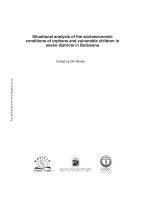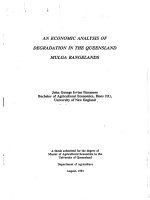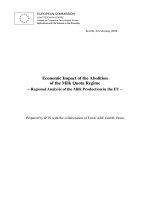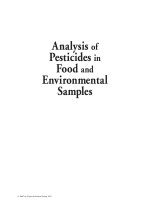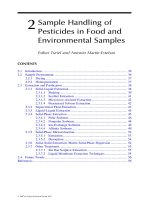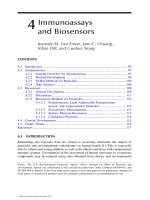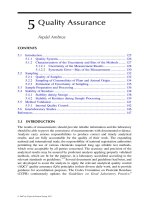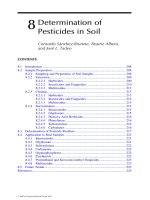Analysis of GC-content in transcriptome sequence of Coscinium Fenestratum (Gaertn.) Colebr Leaf
Bạn đang xem bản rút gọn của tài liệu. Xem và tải ngay bản đầy đủ của tài liệu tại đây (248.37 KB, 5 trang )
Int.J.Curr.Microbiol.App.Sci (2019) 8(2): 3454-3458
International Journal of Current Microbiology and Applied Sciences
ISSN: 2319-7706 Volume 8 Number 02 (2019)
Journal homepage:
Original Research Article
/>
Analysis of GC-content in transcriptome sequence of
Coscinium fenestratum (Gaertn.) Colebr Leaf
Ashalatha and S. M. Gopinath*
Department of Biotechnology, Acharya Institute of Technology,
Bengaluru, Karnataka, India-560107
*Corresponding author
ABSTRACT
Keywords
Guanine,
Cytosine,
Illumina paired end
sequencing
Article Info
Accepted:
29 January 2019
Available Online:
10 February 2019
Coscinium fenestratum (Gaertn.) Colebr, a important medicinal vine is
considered as critically endangered or restricted to the humus rich soil. It
has abundant use in ayurvedic, siddha, tibetan medicine system. The plant
is already Red listed and at the verge of extinction. So a transcriptome
study and the GC analysis of the plant are vital. The research provides
information on its transcriptome and its stability which can be used for
further studies. The leaf tissue of C.fenestratum was collected, sequenced
using illumina paired end sequencing. The raw sequence data quality check
parameters like the average base content and the GC content of the reads
were analyzed. Maximum number of reads showed 43% of the average GC
content in the sample showing slightly instability to adaptation.
Introduction
The ratio of four nitrogenous bases in nucleic
acids may vary significantly in various
genome components, its composition is
conventionally expressed as the percentage of
guanine (G) and cytosine (C) bases (GC
content) in a given region or for the entire
genome (genomic GC content). The study of
GC serves as an important criterion in
predictions of thermo tolerance, of the
variety. However, less attention has been paid
to analyze the GC content of plant genomes,
for which the knowledge of detailed base
composition and its meaning in the ecology
and evolution of particular taxa is still poor.
The cause of variation in GC content is one of
the central issues in evolutionary genomics.
Some models link between GC content and
temperature (Bernardi., 2000; Bernardi &
Bernardi., 1986; Salinas et al., 1988). G: C
pairs are more thermally stable than adenine
(A) and thymine (T) pairs (Wada & Suyama
1986), G: C base pairs being are bonded by
three hydrogen bonds and A: T base pairs by
two. In turn, these interactions seem to be
important in conferring stability to higher
order structure for RNA transcripts (Smarda
et al., 2012; Biro JC, 2008). A similar
suggestion has been made for the evolution of
3454
Int.J.Curr.Microbiol.App.Sci (2019) 8(2): 3454-3458
plant genomes (Salinas et al., 1988). So far,
the highest GC contents of land plants have
been found in grasses (Smarda et al., 2012;
Smarda P et al., 2012; Salinas et al., 1988;
Biswas SB, Sarkar AK 1970). In contrast to
grasses, the lowest GC contents so far
reported in plants Cyperaceae and Juncaceae
(Lipneroval et al., 2013). By contrast, the GC
content of Structural RNAs is higher at high
temperatures.
Profound insight into the genomic
architecture of model plants are rapidly
accumulating, due to high-throughput next
generation and third generation sequencing
techniques (Flagel et al., 2012). However, the
genomic constitution of the vast majority of
nonmodel plants still remains unknown
Genomic DNA base arrangement (GC
content) is anticipated to essentially influence
genome working and species adaptation to
environment.
The
thermal
theory
demonstrates that genomic adjustments
related with changing GC substance may have
assumed a critical job in the development of
the Earth's contemporary biota.
The reasons for the variation between
genomes in their guanine (G) and cytosine (C)
content is one of the focal issues in genomic
studies. This GC and AT content variation is
studied in C.fenestratum leaf transcript which
is showing vulnerability in getting adapted to
all climatic condition. And has been declared
as critically endangered variety and show
much adoption in Western Ghats or humid
area (Ashalatha et al., 2019).
Materials and Methods
Plant Material
The leaf of C.fenestratum is collected and
transferred to a RNA later solution to avoid
RNA degradation.
RNA extraction
The RNA extraction of the leaf sample was
carried out using RNAsolTM Kit. The standard
protocol provided was carried out for
extraction.
RNA Purification
The extracted RNA was checked for 28S:18S
RNA degradation by using an Agilent 2100
Bioanalyzer. The pooled RNA with an RIN
(RNA integrity number) of 7.0 was used for
further mRNA purification process. The
obtained mRNA was further purified by
oligo-dT beads using TruSeq kit.
Sequencing
The cDNA library was prepared and further
the template was sequenced by a standardized
protocol of Illumina paired end sequencing
(Illumina Hi Seq 2500 platform, USA), with a
read length of 101 * 2 by utilizing paired-end
sequencing chemistry technique. The reads
having ≥70% of the bases with a quality score
≥Q20 using NGS QC Toolkit [83] were
chosen for assembling the transcriptome.
Results and Discussion
The present study was obtained an average of
17,342,427 total number of reads owing for
1,751,585,127 number of bases. The raw
sequence data was deposited to the NCBI
BioProject database (as SRA- Short Read
Archive) with the accession number
PRJNA415708. The other quality check
parameters like the average base content and
the GC content of the reads were analyzed.
Maximum number of reads showed 43% of
the average GC content in the sample. The
reads in the samples follows the normal
distribution of the GC content, which is
similar to the theoretical GC distribution
authenticating the quality of transcript
3455
Int.J.Curr.Microbiol.App.Sci (2019) 8(2): 3454-3458
obtained. The data quality obtained is very
good with 95.54% high quality reads the
summary of GC content distribution (Figure:
1) of leaf is provided below.
The results showed 43% of the average GC
content and 57% of AT content in the sample.
This can be inferred as a sparse amount of
thermal instability faced by the plants due to
slightly high amount of A: T content. The
adaptivity of the plant to all environmental
condition is thus low (Franchi G. G., et al
2011).
Figure.1 GC content distribution of Coscinium fenestratum leaf
3456
Int.J.Curr.Microbiol.App.Sci (2019) 8(2): 3454-3458
Acknowledgements
I am thankful to the Team of Bionivid
Technologies, Bangalore for providing me
the technical support and assistance to carry
out my research work.
References
Ashalatha and S.M.Gopinath. (2019).
“Phytochemical profiling of Coscinium
fenestratum (Gaertn.) Colebr, by Liquid
chromatography-Mass
spectrometry”.
Int. J. Curr. Microbiol. App. Sci.
8(1):3194-3201.
Bernardi, G. (2000). Isochores and the
evolutionary genomics of vertebrates.
Gene 241, 3-17.
Bernardi, G. & Bernardi, G. (1986)
Compositional constraints and genome
evolution. J. Mol. Evol. 24, 1-11.
Biro, J.C.
(2008). Correlation
between
nucleotide composition and folding
energy of coding sequences with special
attention to wobble bases. Theor Biol
Med Model 5:14.
Biswas, S.B., Sarkar, A.K.
(1970). Deoxyribonucleic acid base
composition of some angiosperms and
its
taxonomic
significance.
Phytochemistry 9(12):2425–2430.
Franchi, G.G., Nepi, M., Dafni., A, Pacini, E
(2002). Partially
hydrated
pollen:
Taxonomic distribution, ecological and
evolutionary significance. Plant Syst
Evol 234(1-4):211–227.
Lipnerová, I., Bureš, P., Horová, L., Šmarda,
P. (2013). Evolution of genome size
in Carex(Cyperaceae) in relation to
chromosome number and genomic base
composition. Ann Bot (Lond)111(1):79–
94.
Salinas, J., Matassi, G., Montero, L.M., Berna
rdi, G (1988). Compositional compartmentalization and compositional patterns
in
the
nuclear
genomes
of
plants. Nucleic Acids Res 16(10):4269–
4285.
Wada, A. & Suyama, A. ( 1986). Local
stability of DNA and RNA secondary
3457
Int.J.Curr.Microbiol.App.Sci (2019) 8(2): 3454-3458
structure and its relation to biological
functions. Prog. Biophys. Mol. Biol. 47,
113-157.
Šmarda, P., Bureš, P (2012) The variation of
base
composition
in
plant
genomes. Plant
Genome
Diversity,eds Wendel F, Greilhuber J, D
oležel J, Leitch IJ (Springer, Vienna), 1,
209–235.
Šmarda, P., Bureš, P., Šmerda, J., Horová, L.
(2012). Measurements of genomic GC
content in plant genomes with flow
cytometry: A test for reliability. New
Phytol 193(2):513–521.
Flagel,L.E., Blackman, B.K(2012).The first
ten years of plant genome sequencing
and prospects for the next decade. Plant
Genome Diversity, eds Wendel JF,
Greilhuber J, Dolezel, Leitch IJ
(Springer, Vienna), 1,1-15
How to cite this article:
Ashalatha and Gopinath, S. M. 2019. Analysis of GC-content in transcriptome sequence of
Coscinium fenestratum (Gaertn.) Colebr Leaf. Int.J.Curr.Microbiol.App.Sci. 8(02): 3454-3458.
doi: />
3458
